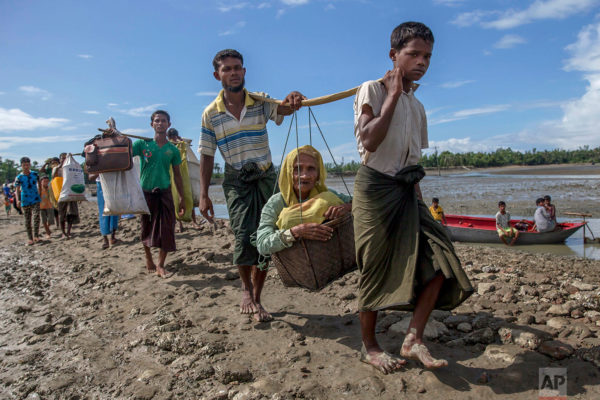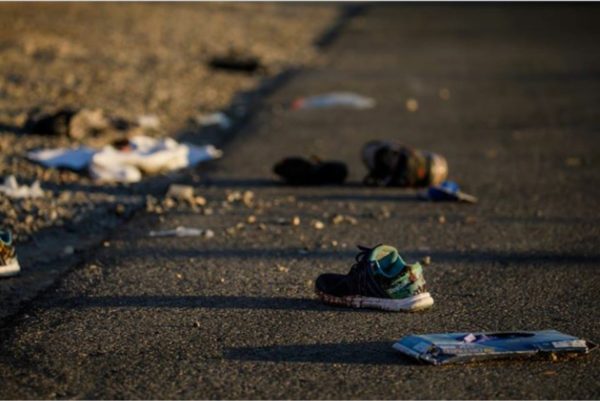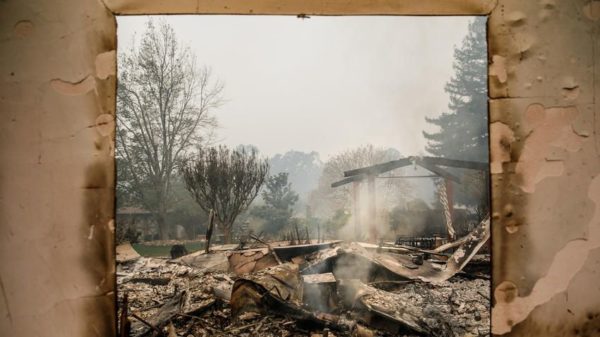Notes
On that Rohingya Woman in a Basket

To carry something in public is a communicative act, a tacit but highly visual claim about one’s identity and place in the world. For most of us, this is a trivial matter, at the level of which bag to accessorize with or what and how to pack for a trip. For people who do not have permanent or secure homes, carrying gets complicated; it becomes a more overtly political act.
Consider the homeless person who pushes a pilfered shopping cart filled with all their (seemingly valueless) earthly possessions through the inhospitable city. Or the refugee who must choose which pieces of their life to salvage before fleeing and leaving everything else behind. After all, carrying expresses a commitment; when I occupy my hands and body with carrying something, I effectively wager that I will not encounter anything better or more important, that nothing will startle me into dropping it or entice me into discarding it.
In the vast imagery of the ‘Rohingya crisis,’ there is a lot of carrying. Boats carrying passengers, people of all ages carrying sacks of belongings, adults carrying babies (alive or otherwise), and occasionally, adults carrying other adults. Out of all of these pictures of carrying, however, I find something especially compelling about this image of an elderly woman being borne along in a basket.
Along with her two male bearers, the woman occupies the foreground of the scene, trailed by a seemingly endless line of people walking, as the caption tells us, toward a refugee camp in Bangladesh. Off to the side, there is a group of boys in a small boat that seems to have run aground. The sky is the sky-blue of the so-named crayon, with just a few thin clouds. Judging by the light and shadow, it seems to be afternoon. Their path, presumably worn by the people who went before them, is muddy and unevenly laid with rocks. The landscape looks tidal. In the background, there are telephone poles listing sideways, connecting wires too thin to be visible from this distance (something of a metaphor for the obfuscation by Myanmar’s leaders, perhaps). With the exception of the woman in the basket, everyone else in the photo appears to be male, wearing bright clothes in mismatched patterns or sarongs, often carrying satchels. The photographer has captured them in mid-step. Each of the two young men carrying the elderly woman has a foot raised off the ground, their knees bent, I guess to keep momentum despite the suction of the soggy ground. We can see their toes, and the architecture of bones and tendons and veins in their feet. The basket seems to be swaying a little but the woman appears to be keeping her equilibrium.
Virtually everyone in the photo seems to be directing their attention to the camera: the young men carrying the basket, the elderly woman, the trail of people behind them, the boys in the stranded boat. Most of their expressions are inscrutable, shades of despair, amusement, fatigue, curiosity, and defiance all commingled. The woman’s mouth is open, revealing missing teeth, but it is unclear whether she is trying to speak, and if so, to whom. These direct gazes do not seem confrontational, exactly, but they do seem to be intentional. They are not, however, desperate or pleading (though we see such faces in other photos of the refugees), as if to suggest that the meaning of scene, and everything they are carrying, is self-evident but also beyond description.
While the men’s clothing looks dirty and a little worn, the woman herself appears to be dressed with care. She is wearing earrings, a silver band on her left ring finger, and a bracelet above her right wrist. The yellow of the scarf draped over her head is a beautiful complement to the pale green of her clothing (and an uncanny one to the blue of the sky). She does not seem to be carrying anything else with her; her hands are empty, the left one curled into a loose fist and the right one resting on the edge of the basket. As I stared at this photo, I found myself wondering—absurdly—about how she decided what to wear, what she intended to communicate by leaving her home with these particular items of clothing, what she did not take.
And then there are the logistics and physics of this scene. The ropes holding the basket seem impossibly thin (something of a metaphor for the precariousness of their situation, perhaps). Did they strain or fray over time? Was the basket designed and fabricated for this purpose? How did she fold herself up small enough to fit? Did her joints hurt? The men do not appear to be struggling, though one imagines that they are tired or achy or hungry—is she very light? Or are they very strong? Does the wooden brace from which her basket is suspended do something to distribute the weight more manageably? How did they settle on this mode of conveyance? How did they know it would work?
Silly questions? In another context, the sight of a woman contorted to fit into a too-small basket might just be a visual gimmick or a joke. But as a communicative act, the picture tells a story about her preciousness to the men that are carrying her, to the exclusion of carrying anything else. This act of carrying likewise conveys the desperation of their circumstances. And its novelty hints at the impossibility of comprehending such displacement to those of us who are unlikely to ever experience such a thing.
— Rebecca Adelman
Photo: Dar Yasin/AP Caption: Rohingya Muslims, who crossed over from Myanmar into Bangladesh, carry an elderly woman in a basket and walk towards a refugee camp in Shah Porir Dwip, Bangladesh, Thursday, Sept. 14, 2017.


Reactions
Comments Powered by Disqus